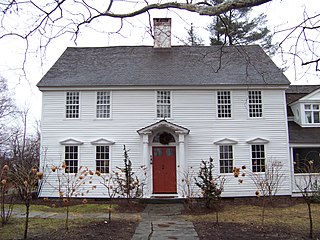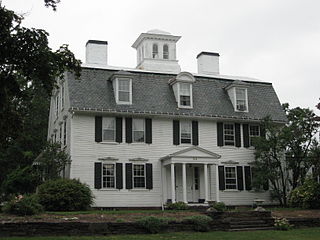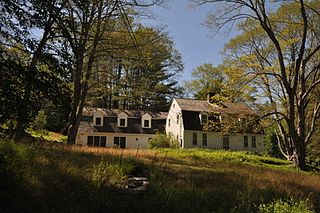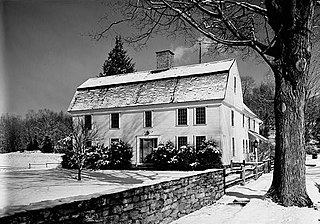
The Nehemiah Hubbard House is a historic house at the corner of Laurel Grove and Wadsworth Street, Middletown, Connecticut. Built in 1745, it is a center-chimney colonial style house built of clapboard siding and brownstone foundation with wood shingle roof; using a structural system of wood frame, post and beam with gable roof. It was built as a residence which is its current use.

The Oliver Wolcott House is a historic colonial home at South Street near Wolcott Avenue in Litchfield, Connecticut. It was built in 1753 by Founding Father Oliver Wolcott Sr., a signer of the Declaration of Independence and the Articles of Confederation, and a state militia leader in the American Revolutionary War. It is the oldest house in the borough. It was the home of Oliver Wolcott Sr. (1726–1797), and is where his son Oliver Wolcott Jr., was born. Many distinguished guests visited the Wolcott House, including Lafayette and George Washington, who stayed there in 1780 during his first visit to Litchfield. The house was declared a National Historic Landmark in 1971. It is located on South Street, nearly opposite to Wolcott Avenue. The house is not open to the public.

The General John Glover House is a National Historic Landmark at 11 Glover Street in Marblehead, Massachusetts. It is a 2+1⁄2-story gambrel-roofed colonial built in 1762 by John Glover (1732–1797), a local merchant, politician, and militia leader who gained fame for his military leadership in the American Revolutionary War. The house was declared a National Historic Landmark and added to the National Register of Historic Places in 1972, for its association with Glover, who lived here during the war years.

The Manse is a historic church manse in Northampton, Massachusetts. With a construction history dating to 1744, it is in part a good example of vernacular mid-18th century architecture. It has also had a procession of locally notable owners and residents. The house was listed on the National Register of Historic Places in 1976.

The Simon Tiffany House, also known as the Ebenezer Tiffany House, is a historic house on Darling Road in Salem, Connecticut. Built about 1793, it is a well-preserved example of a rural vernacular farmhouse of the period. It was listed on the National Register of Historic Places in 1983.

The Henry Champion House is a historic house on Westchester Road in Colchester, Connecticut. Built in 1790, it is a good local example of Federal period architecture, designed by William Sprat, a prominent early architect. It was built by Colonel Henry Champion, a veteran of the American Revolutionary War for his son, also named Henry. The house was listed on the National Register of Historic Places in 1972.

The Bradford-Huntington House is a historic house at 16 Huntington Lane in the Norwichtown section of Norwich, Connecticut, United States. The house was built in stages, beginning around 1691, and is one of the oldest to survive in the area. It was owned by American Revolutionary War officer Jabez Huntington. It is claimed that Huntington hosted George Washington here. The house was listed on the National Register of Historic Places in 1970. It is also a contributing property in the Norwichtown Historic District.
The Marshall House is a house in Schuylerville, New York listed on the National Register of Historic Places for both its place in American history and its architectural significance.

The Shaw Mansion, also known as the Shaw-Perkins Mansion and as the Shaw Mansion Museum, is a historic mansion and house museum at 11 Blinman Street between Bank and Brewer Streets in New London, Connecticut. Built in 1756 for Nathaniel Shaw Sr., it is a well-preserved example of a wealthy merchant's house, made further notable as the location of the state's naval offices during the American Revolutionary War. The headquarters and museum of the New London County Historical Society have been located in the Shaw Mansion since 1907.

The Jabez Smith House is a historic house museum at 259 North Road in Groton, Connecticut. Built about 1783, it is the only 18th-century farmhouse to survive on Groton's Poquonock Bridge area, which was once its principal agricultural area. It is owned by the town of Groton and open to the public on weekends from April through November. It features 18th and 19th-century antiques. The house was listed on the National Register of Historic Places on May 15, 1981.

The Whitehall Mansion is a historic house at 42 Whitehall Avenue in the Stonington side of Mystic, Connecticut. Built about 1771 for a local physician and politician, it is a fine example of late Georgian architecture. It has been moved twice, both times short distances, and now serves as a bed and breakfast inn. The house was added to the National Register of Historic Places on April 12, 1979.

The War Office, also once known as the Capt. Joseph Trumble Store and Office, is a historic commercial building on the Lebanon Green in Lebanon, Connecticut, built about 1732 as a commercial building. It is most significant as the place from which Governor Jonathan Trumbull conducted military business during the American Revolutionary War. It is now part of the museum property managed by the Connecticut Society of the Sons of the American Revolution that also includes the Trumbull House and the Wadsworth Stables. The building was listed on the National Register of Historic Places in 1970.

The Edward Yeomans House is a historic house on the waterfront of Palmer Cove on Brook Street in the Noank section of Groton, Connecticut. With its construction dating to 1713, it is believed to be Noank's oldest surviving structure, built by one of its early settlers. The house was listed on the National Register of Historic Places on December 22, 1978.

The Cove Island Houses, although plural in name, is a single house in Cove Island Park, in Stamford, Connecticut. The house was expanded from a first section that dates from 1791, and is now predominantly a Georgian style house with an older wing. It is the only building that is a legacy of the large Stamford Mills complex at the Cove. It was listed on the National Register of Historic Places in 1979. It presently houses administrative offices of Cove Island Park.
The Cover Farm is an historic farmstead on Maine State Route 3 in the Hulls Cove village of Bar Harbor, Maine on Mount Desert Island. Its centerpiece is an early 19th-century Cape, set on a parcel of land owned until 1810 by the granddaughter of the island's original French proprietor, Antoine de la Mothe Cadillac. In the early 20th century, the property was transformed into a summer estate, with the addition of a Colonial Revival wing and a walled garden. The property was listed on the National Register of Historic Places in 1995.
The Peter Powers House is a historic house on Sunshine Road, just east of Maine State Route 15 in Deer Isle, Maine. This 1+1⁄2-story Cape style house was built in 1785 for Rev. Peter Powers, the first settled minister of the town, and is the oldest surviving house in the town. It is also architecturally distinctive as a rare regional example of a gambrel-roofed Cape. The house was listed on the National Register of Historic Places in 1980.

The Hager Farm is a historic farmstead on United States Route 7 in southern Wallingford, Vermont. Its farmhouse, built about 1800, is one of the oldest in the community, and is regionally unusual because of its gambrel roof. The property was listed on the National Register of Historic Places in 1986.

The Whittier House is a historic house on Greenbanks Hollow Road in Danville, Vermont. Built in 1785, it is significant as one of the town's oldest surviving buildings, and as an example of a gambrel-roofed Cape, a style rare in northern Vermont but common to Essex County, Massachusetts, where its builder was from. The house was listed on the National Register of Historic Places in 1984.

The John Robbins House is a historic house at 262 Old Main Street in Rocky Hill, Connecticut. Normally attributed a construction date of 1767, it is considered one of the finest examples of brick Georgian architecture in the state. It was listed on the National Register of Historic Places in 1988.

The Plaster House is a historic house at 117 Plaster House Road in Southbury, Connecticut. Probably built in the mid-18th century, it is an extremely rare example of 18th-century stone residential construction in the state. The small structure may have originally been built as a farm outbuilding by a member of locally prominent Hinman family. It was listed on the National Register of Historic Places in 1993.



















